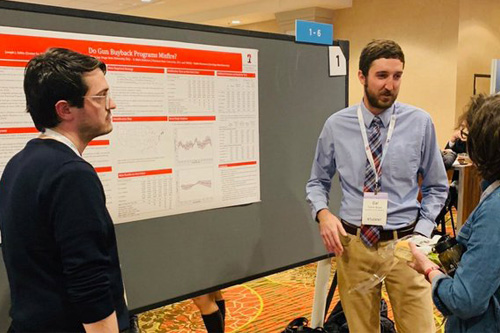
M.S. in Economics
STEM-designated
Advanced training in economic data, market, and policy analysis
Degree Learning Outcomes:
- Proficiency with advanced microeconomic analysis, including: constrained and unconstrained
optimization, comparative statics, market equilibrium, strategy, welfare and policy
analysis.
- Proficiency with advanced econometric data management, analysis, and causal inference
methods, including: multiple regression, instrumental variables, panel data methods,
and difference-in-differences.
- The combined application of microeconomic and econometric analysis for academic, private-
and public-sector research, including proficiency in data management and statistics
with modern software tools.
Why choose our program?

Research & Teaching Opportunities
- Joint publications
- Professional conference presentations
- Teach a principles level course

- Elective coursework in math, statistics, finance, GIS and more
- Three semester option
See where our degree can take you.
 Alumni Spotlight: Tim Mahedy
Alumni Spotlight: Tim Mahedy
Tim Mahedy received his M.A. in Economics from San Diego State University in 2011. He recently founded Access/Macro, an economic consulting firm based in San Diego with the mission to push beyond the forecasts and numbers to help companies build actionable solutions for today’s volatile economy. Prior to starting A/M, Tim worked at KPMG, the Federal Reserve Bank of San Francisco, Bloomberg, and Citibank. He has co-authored articles published by the FRBSF, IMF, and Bloomberg outlets, conducted economic forecasting at the IMF and the Federal Reserve, and has gained a reputation for synthesizing complex economic developments for business and community leaders. His research covers a wide range of topics, but he specializes in inflation and monetary policy. His work is regularly cited in the press and remains influential with policymakers.
"I took a quantitative route while studying for my MA in Economics at SDSU. My coursework focused on microeconomic foundations, econometrics, and statistics. I was told after I started my first job in economics at the International Monetary Fund that there's no way I would have landed the job without that high level training.” – Tim Mahedy
 Alumni Spotlight: Brittany Bass
Alumni Spotlight: Brittany Bass
Brittany Bass received her M.A. in Appplied Economics from SDSU and Ph.D. in Economics from the University of California, Irvine. She is currently an Economist for the Integrated Substance Abuse Programs in the Semel Institute at the University of California, Los Angeles. Brittany is a health economist, primarily researching the impact of policies related to substance use disorder treatment on youth and adult health and economic outcomes. Her past research has focused on examining the impact of sex education mandates, maternity leave laws, minimum wages, and technology funding. Brittany's research has appeared in peer-reviewed economics and policy journals including Economics of Education Review, Contemporary Economic Policy, IZA Journal of Labor Policy, and Journal of Population Economics.
